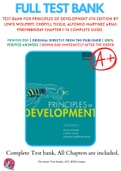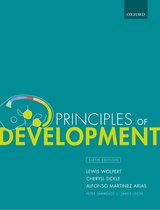PRINTED PDF | ORIGINAL DIRECTLY FROM THE PUBLISHER | 100%
VERIFIED ANSWERS | DOWNLOAD IMMEDIATELY AFTER THE ORDER
For more Test banks, ATI, HESI exams
FULL TEST BANK
T e s t B a n k F o r P r i n c i p l e s o f D e v e l o p m e n t 6 t h E d i t i o n B y L e w i s W o l p e r t ; C h e r y l l T i c k l e ; A l f o n s o M a r t i n e z A r i a s 9 7 8 0 1 9 8 8 0 0 5 6 9 C h a p t e r 1 - 1 4 C o m p l e t e G u i d e .
Complete Test bank, All Chapters are included. Wolpert et al, Principles of Development 6e Test bank © Oxford University Press, 2019. Type: multiple choice question Title: Chapter 01 - Question 01 01) Which of these terms refers to the “generation of form?” a. Developmental biology Feedback: No, developmental biology is the field of biology focused on understanding how animals and plants develop. Page reference: 2 b. Embryogenesis Feedback: No, embryogenesis is the development of an embryo from a fertilized egg. Page reference: 2 *c. Morphogenesis Feedback: Yes, morphogenesis is the development of form. The meaning comes from the words “morph” (form) and “genesis” (generation of). Page reference: 2 d. Embryology Feedback: No, embryology is an outdated term to describe the study of developmental biology. Modern developmental biologists appreciate that development of an organism continues after embryogenesis. Page reference: 3 Type: multiple choice question Title: Chapter 01 - Question 02 02) Which of these is true of meiosis? *a. Germ cells are formed through this process. Feedback: Yes, this is true. Germ cells, sperm and egg, are formed when a diploid cell undergoes meiosis to give rise to four cells containing half the number of chromosomes (haploid). Page reference: 6 b. A zygote is formed through this process. Feedback: No, this is not true. A zygote is formed when fusion of a haploid egg nucleus with a haploid sperm nucleus takes place. Page reference: 5 c. This process is carried out during cleavage stage. Feedback: No, this is not true. Cleavage stage is when a single-celled zygote undergoes rapid mitotic cell divisions. Page reference: 14 d. Daughter somatic cells are formed containing the same number of chromosomes as the parental cell. Feedback: No, this is not true. Mitosis is the type of cell division somatic cells use to keep the number of chromosomes constant from parental cell to daughter cells. Page reference: 5 Type: multiple choice question Title: Chapter 01 - Question 03 03) What is the key hypothesis of a mosaic model for developmental fate regulation? a. Normal development occurs even if cells are removed. Feedback: No, if normal development proceeds even after cell removal this highlights an embryo’s ability to regulate for this cell loss. This is t he opposite of mosaic development where cytoplasmic determinants are specific to a subset of embryonic cells. Page reference: 24 b. Zygotic proteins and RNAs are equally distributed to daughter cells Feedback: No, zygotic cytoplasmic determinants are expected to be unequally distributed among daughter cells during cleavage events. This is how subpopulations of embryonic cells would establish different characteristics within the context of a mosaic model. Page reference: 24 www.nursylab.com
www.nursylab.com Wolpert et al, Principles of Development 6e Test bank © Oxford University Press, 2019. *c. Patterns of cell division control embryonic cell fate. Feedback: Yes, cytoplasmic determinants within the zygote are distributed unequally within daughter cells during cleavage stage. Each cell’s determinants control the future fate of that cel l. Page reference: 24 d. Cells within an early embryo communicate with each other. Feedback: No, cell-cell communication is a key expectation of cells within an embryo capable of regulating for cell loss. It is understood that communication is necessary for sensing cell loss . Page reference: 24 Type: multiple choice question Title: Chapter 01 - Question 04 04) The influence of one cell over another neighbouring cell’s development is called. a. Interaction Feedback: No, induction is where one cell, or tissue, directs the development of another neighbouring cell or tissue through cell-cell signalling. Page reference: 8 b. Communication Feedback: No, induction is where one cell, or tissue, directs the development of another neighbouring cell or tissue through cell-cell signalling. Page reference: 8 c. Organization Feedback: No, induction is where one cell, or tissue, directs the development of another neighbouring cell or tissue through cell-cell signalling. Page reference: 8 *d. Induction Feedback: Yes, induction is where one cell, or tissue, directs the development of another neighbouring cell or tissue through cell-cell signalling. Page reference: 8 Type: multiple choice question Title: Chapter 01 - Question 05 05) Which of the options given is not true of the Spemann-Mangold organizer experiment? a. The transplanted tissue is the dorsal lip of the blastopore. Feedback: No, this is true. The transplanted tissue is the dorsal lip of the blastopore from an unpigmented embryo. Page reference: 8 b. A secondary body axis developed, containing neural tube and somites. Feedback: No, this is true. The dorsal blastopore lip transplantation into the ventral surface of another embryo induced a secondary axis. Page reference: 8 c. The transplanted tissue resides near the region where gastrulation begins. Feedback: No, this is true. The blastopore is the site where gastrulation begins in the newt. The dorsal lip of the slit-like invagination is the organizer tissue. Page reference: 8 *d. Every induced tissue was pigmented. Feedback: No, this is not true. Tissues within the induced secondary axis contained cells of graft (unpigmented) and host (pigmented) origin. This suggests that cells within the graft tissue send inductive signals to the host tissue. Page reference: 8 Type: multiple choice question Title: Chapter 01 - Question 06 06) Which developmental process establishes a coordinate system whereby cells “know” their location within an embryo? www.nursylab.com
www.nursylab.com Wolpert et al, Principles of Development 6e Test bank © Oxford University Press, 2019. a. Morphogenesis Feedback: No, morphogenesis is the generation of form through cell shape change and movements. Page reference: 16 b. Cell differentiation Feedback: No, differentiation is the process of cells becoming structurally and functionally different from each other, ending up as distinct specialized cell types. Page reference: 16 *c. Pattern formation Feedback: Yes, pattern formation involves the establishment of a body plan with defined main body axes. Cells with knowledge of their spatial position along the anterio-posterior, dorso-
ventral, and right-left axes can develop accordingly. Page reference: 14 d. Growth Feedback: No, growth is the increase in size. Growth can occur through increases in cell number or size. Page reference: 16 Type: multiple choice question Title: Chapter 01 - Question 07 07) Pancreatic and muscle cells are specialized to perform distinct functions but contain t he exact same set of genetic instructions. Which of the options given does not represent a mechanism to accomplish this? *a. Differentiated cells lose genes that are unrelated to their function. Feedback: Yes, this is not a proper mechanism. Animal cloning experiments, such as the one performed by John Gurdon, suggest that adult differentiated cells contain the same set of genetic instructions as cells within the early embryo. Page reference: 19 b. Differentiated cells contain distinct gene-regulatory proteins Feedback: No, this is a proper mechanism. Gene regulatory proteins, in different combinations, determine the list of genes that are expressed in specific cell types within the organism. Page reference: 19 c. Differentiated cells use distinct gene control regions. Feedback: No, this is a proper mechanism. Gene regulatory proteins, in different combinations, bind to and activate or repress specific DNA control regions. This creates a bank of expressed cell-specific genes that dictates a cell ’s function. Page reference: 20 d. Differentiated cells undergo specific types of post-translational protein modification . Feedback: No, this is a proper mechanism. Even if a gene is expressed and the protein produced, cells can modify the same protein differently between cell types. This can lead to differences in cellular behaviour. Page reference: 18 Type: multiple choice questi on Title: Chapter 01 - Question 08 08) What do we call a group of cells that differentiates according to its normal fate after it has been isolated from the embryo and cultured in a neutral environment? a. Determined Feedback: No, determination is assessed by transplanting cells from their normal embryonic region to an ectopic embryonic region and observing their fate. Page reference: 22 b. Chimeric Feedback: No, a chimera is a mosaic of cells with different genetic make-up. Page reference: 24 www.nursylab.com
www.nursylab.com





